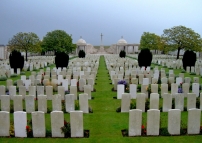| First Name: | Alfred | Last Name: | BOTTRILL | |
|---|---|---|---|---|
| Date of Death: | 26/09/1915 | Lived/Born In: | Middlesex | |
| Rank: | Private | Unit: | Essex11 | |
| Memorial Site: | Loos Memorial, France | |||
Current Information:Age-22 Born-Thorpe-in-the-Glebe, Nottinghamshire The Battle of Loos 25th September - 13th October 1915 This was fought by the British Army along a six-and-a-half-mile front running north from the mining village of Loos on the outskirts of Lens in Northern France. It was the largest offensive carried out by the British so far. The opening day involved an attack by six divisions, with others entering the fray as it progressed and it was part of a much wider offensive with the French launching their own attacks in Champagne and at Vimy. It was the first time that the British used gas during the war, despite their condemnation of the Germans for doing the same in April 1915. There were some encouraging results on the first day but no major breakthrough was achieved and in the succeeding days of it became bogged down in brutal trench warfare. By mid-October the battle had petered out with the British having suffered over 60,000 casualties during its course. The reserve Corps for the battle, XI Corps, consisted of the Guards Division and two New Army divisions, 21st and 24th Divisions, made up of volunteers who had responded to Kitchener’s appeal, and who had only arrived in France at the beginning of September 1915. Nevertheless they were soon in battle. Field Marshal French kept them back from the front when the main attack went in on 25th September but when things did not go to plan these reserves were urgently called for. Even so they were held back until the last minute which meant that they had to march across country through a night of heavy rain to reach the battlefield. It was not until the late morning of 26th September that they were in position to assault the German second line between Bois Hugo & Hulluch. But by this time the enemy had brought up reserves and were launching counter attacks which further disrupted proceedings. What happened next was a disaster. Advancing in broad daylight in ten columns, without the help of an artillery barrage these totally inexperienced divisions were cut to pieces by machine gun and rifle fire. They lost half of their number in a matter of minutes. Even the Germans were shocked at the slaughter and stopped firing to allow the survivors to withdraw. At 11am, 26th September, 24th Division’s attack was carried out by 72 Brigade, with two battalions of 71 Brigade, 11th Essex and 9th Suffolk in reserve. The attack involved a long advance over a bare and open stretch enfiladed from both flanks and although their objective was only a single trench it was protected by wire 4 feet high and 20 feet wide. It was further protected at its ends and middle by three strong closed works, Stützpunkte III, IV & V,. and a number of concrete machine gun emplacements making it a very strong position. Furthermore it had been reinforced during the night and now had six German battalions manning its one mile length. 9th East Surrey and 8th Royal West Kent led the advance. 8th East Kent (Buffs) followed 9th East Surrey on the right of the brigade front but as they moved further forward, they met increasing fire both from in front and from the flanks which desperately thinned the ranks of all four battalions of 72 Brigade. But they continued with their advance and made it as far as the German wire where all forward progress ended The two reserve battalions, 11th Essex & 9th Suffolk remained in reserve in the old German front trench around Lone Tree until shortly after 11.25am, when 11th Essex were sent forward to support 8th Royal West Kent whilst 9th Suffolk moved up behind the centre of the attack. All this gave the forward movement more impetus until 9th Suffolk were brought to a stop by heavy fire some 200 yards past the Lens road. Some of 11th Essex made a gallant effort to reach Hulluch but eventually took refuge in a sunken road whilst the rest of the battalion continued on towards Stutzpunkt IV, some mingling with 8th Royal West Surrey in front of the wire. There being no way forward, someone shouted ‘Retire’ and they did, moving back some 600 yards until they were rallied and took up positions in trenches west and south-west of Hulluch. Here they remained for the rest of the day under heavy bombardment. That night, attempts to bring back the killed and wounded were thwarted by the enemy who re-occupied their old trenches along the Hulluch-Lens road. Only a dozen or so of the lightly wounded managed to crawl back. Casualties for 11th Essex on this day were 370 officers and men. |
||||
| « Back to Search Results | ||||
| If you think any of the information shown here is incorrect, Click Here to submit your amends and comments | ||||




